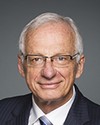That's quite an answer, Chief.
Ms. Blaney, thank you for the question.
To all our witnesses, it's really an honour for us to receive this information. I wish all Canadians could be tuned in to hear your testimony.
We'll do our best as a committee, working with the analysts, to make sure it is captured in our report. Once again, if there's anything further you feel needs to be added, please submit it in writing before this weekend, and we'll see that it gets into the report.
Once again, thank you all.
Before we leave, committee, we have a brief matter of committee business, the adoption of a budget for the study. You received it yesterday. It covers all the costs related to our meetings, including witness expenses.
Having looked at that, do I have unanimous consent to adopt the proposed budget in the amount of $3,750?
Thumbs up, please, for agreement.
I see a roomful of thumbs. Thank you very much.
Thank you, all. It was difficult with the technical issues, but we've listened and we've learned, and hopefully we'll be able to enact things that solve many of the problems we've been hearing.
Our next meeting to continue the COVID study is from 6:30 p.m. to 8:30 p.m., on Thursday.
This meeting is adjourned.


